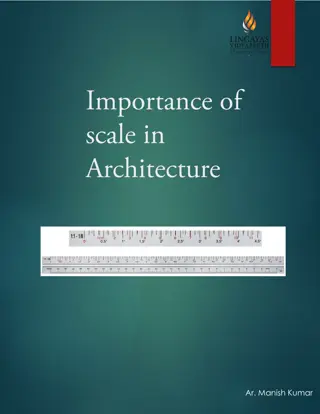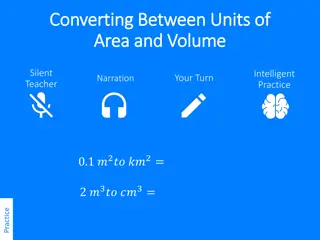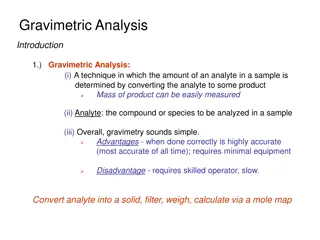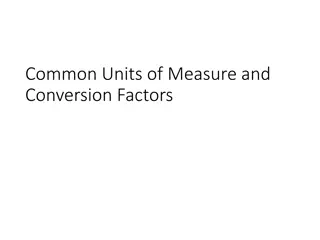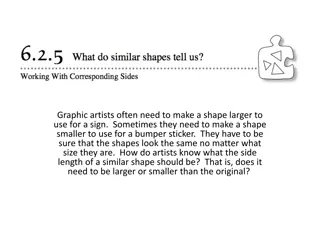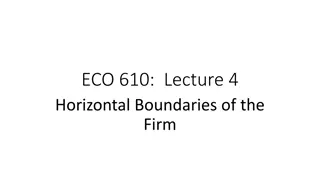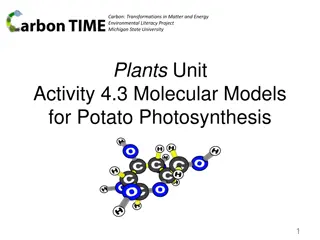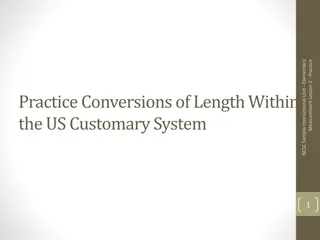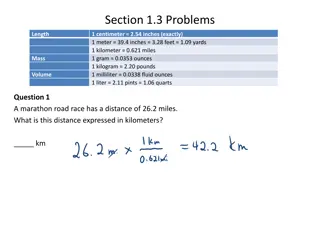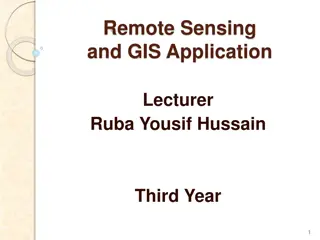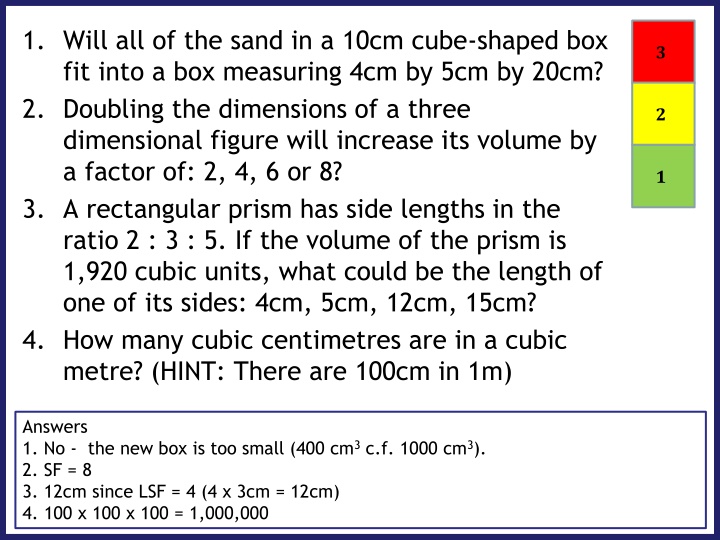
Volume Scale Factors and Dimensional Changes
Explore concepts such as volume scale factors, linear scale factors, and how dimensional changes affect the volume, area, and scale of objects in three dimensions. Learn about the relationship between the sizes of different shapes, how to calculate scale factors, and various examples illustrating these mathematical principles.
Download Presentation

Please find below an Image/Link to download the presentation.
The content on the website is provided AS IS for your information and personal use only. It may not be sold, licensed, or shared on other websites without obtaining consent from the author. If you encounter any issues during the download, it is possible that the publisher has removed the file from their server.
You are allowed to download the files provided on this website for personal or commercial use, subject to the condition that they are used lawfully. All files are the property of their respective owners.
The content on the website is provided AS IS for your information and personal use only. It may not be sold, licensed, or shared on other websites without obtaining consent from the author.
E N D
Presentation Transcript
1. Will all of the sand in a 10cm cube-shaped box fit into a box measuring 4cm by 5cm by 20cm? 2. Doubling the dimensions of a three dimensional figure will increase its volume by a factor of: 2, 4, 6 or 8? 3. A rectangular prism has side lengths in the ratio 2 : 3 : 5. If the volume of the prism is 1,920 cubic units, what could be the length of one of its sides: 4cm, 5cm, 12cm, 15cm? 4. How many cubic centimetres are in a cubic metre? (HINT: There are 100cm in 1m) ? ? ? Answers 1. No - the new box is too small (400 cm3 c.f. 1000 cm3). 2. SF = 8 3. 12cm since LSF = 4 (4 x 3cm = 12cm) 4. 100 x 100 x 100 = 1,000,000
Enlargement and Reduction If the side of the small cube is D cm long, complete the table below: Small Big SF Length cm Area cm 2 Volume cm 3 What are the scale factors in going from big to small? There are two ways of saying this. What are they?
Enlargement and Reduction If the side of the small cube is D cm long, complete the table below: Small Big SF Length cm Area cm 2 Volume cm 3 D 2 D 4 D 2 8 D 3 2 4 8 D 2 D 3 What are the scale factors in going from big to small? There are two ways of saying this. What are they?
Enlargement and Reduction If the side of the small cube is D cm long, complete the table below: Small Big SF Length cm Area cm 2 Volume cm 3 D 2 D 4 D 2 8 D 3 2 4 8 D 2 D 3 What are the scale factors in going from big to small? Divide by 2, 4 or 8 There are two ways of saying this. What are they? Multiply by , , or
Consider the scale factor tables that we have looked at previously: Table 1 Small Large SF Length cm Area cm 2 Volume cm 3 2 4 8 4 2 4 8 16 64 Table 2 Small Large SF Length cm Area cm 2 Volume cm 3 D 2 D 4 D 2 8 D 3 2 4 8 D 2 D 3 Table 1: Small SF = 2 every time. Large = 4 every time. Table 2: Small SF = D every time. Large = 2D every time. Connection: the large SF is always twice that of the small, as the What are the scale factors following the red arrows? What is the connection between the small and the big SF following this direction? Why is this? larger shape has been enlarged by a scale factor of 2 in all dimensions.
Volume, Area and Linear Scale Factors combined Previously we learned about the connection between a linear scale factor and the area and volume scale factors of similar objects: Area Scale Factor = (Linear Scale Factor)2 Volume Scale Factor = (Linear Scale Factor)3 Discuss: if we know the volume scale factor, how could we calculate the area scale factor?
Volume, area and linear scale factors together: The larger tin of beans has a mass of 400g while the smaller tin has a mass of 50g. The label on the smaller tin has an area of 150cm2. Assuming that all dimensions are similar, calculate the area of the label on the larger tin. http://farm4.static.flickr.com/3431/3955349689_4f98581a6c.jpg ??? ?????=400 VSF = 50= 8 38 = 2 LSF = ASF = 22= 4 Area of label = 4 x 150 = 600cm2
2 1 B A A B x 4cm x 30cm The volume of solid A is 12cm . The volume of solid B is 96cm . Find the length x. The volume of solid A is 800cm . The volume of solid B is 172.8cm . Find the length x. 3 4 The volume of solid A is 13m . The volume of solid B is 351m . The surface area of solid A is 24cm . Calculate the surface area of solid B. The volume of solid A is 288cm . The volume of solid B is 4.5cm . The surface area of solid A is 322cm . Calculate the surface area of solid B. B A B A
SOLUTIONS 2 1 B A A B x 4cm x 30cm The volume of solid A is 12cm . The volume of solid B is 96cm . Find the length x. The volume of solid A is 800cm . The volume of solid B is 172.8cm . Find the length x. 8cm 50cm 3 4 The volume of solid A is 13m . The volume of solid B is 351m . The surface area of solid A is 24cm . Calculate the surface area of solid B. The volume of solid A is 288cm . The volume of solid B is 4.5cm . The surface area of solid A is 322cm . Calculate the surface area of solid B. B A B A 20.125cm 207cm
Exam Question Two solid cones are mathematically similar. Cone A has a volume of 120 cm3 Cone B has a volume of 960 cm3 Work out the ratio of the surface area of cone A to the surface area of cone B.
Exam Question A company makes monsters. The company makes small monsters with a height of 20 cm. A small monster has a surface area of 300 cm2. The company also makes large monsters with a height of 120cm. A small monster and a large monster are mathematically similar. Work out the surface area of a large monster.
Exam Question The surface area of cone B is 12.25 times bigger than cone A. If the volume of cone B is 380cm3, calculate the volume of cone A. Give your answer correct to 3 significant figures. ASF = 12.25 A B LSF A to B = 12.25 = 3.5 VSF A to B = 3.53 = 42.875 380 42.875 = 8.86cm3 (3 sig fig)
Exam Question Two similar pyramids A and B have surface areas 180 cm2 and 80 cm2 respectively. The volume of pyramid A is 810 cm3. Show that the volume of pyramid B is 240 cm3.
Exam Question Two similar pyramids A and B have surface areas 180 cm2 and 80 cm2 respectively. The volume of pyramid A is 810 cm3. Show that the volume of pyramid B is 240 cm3.


